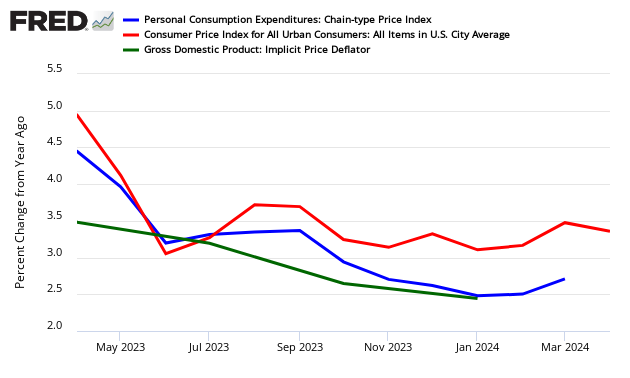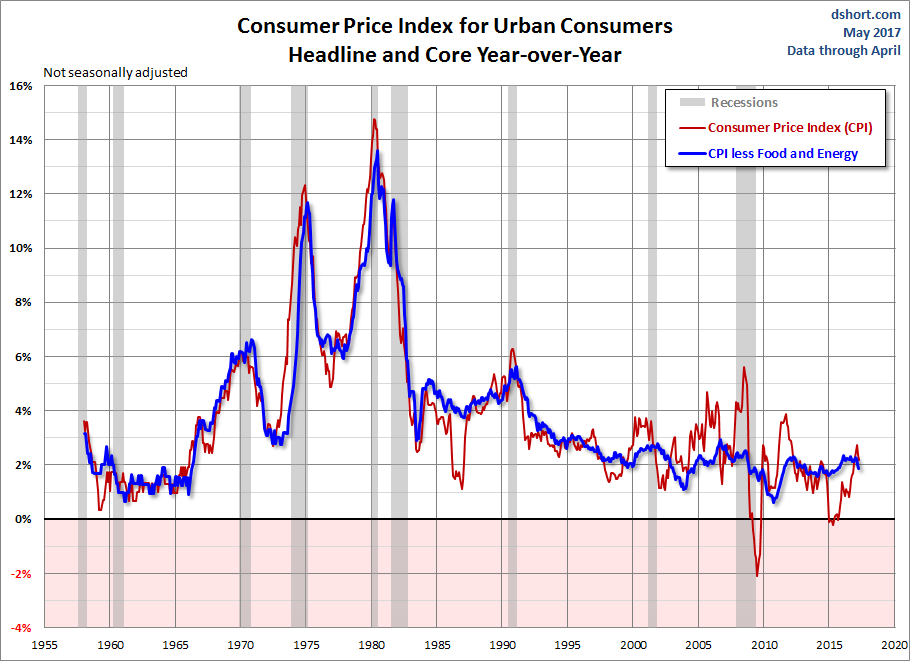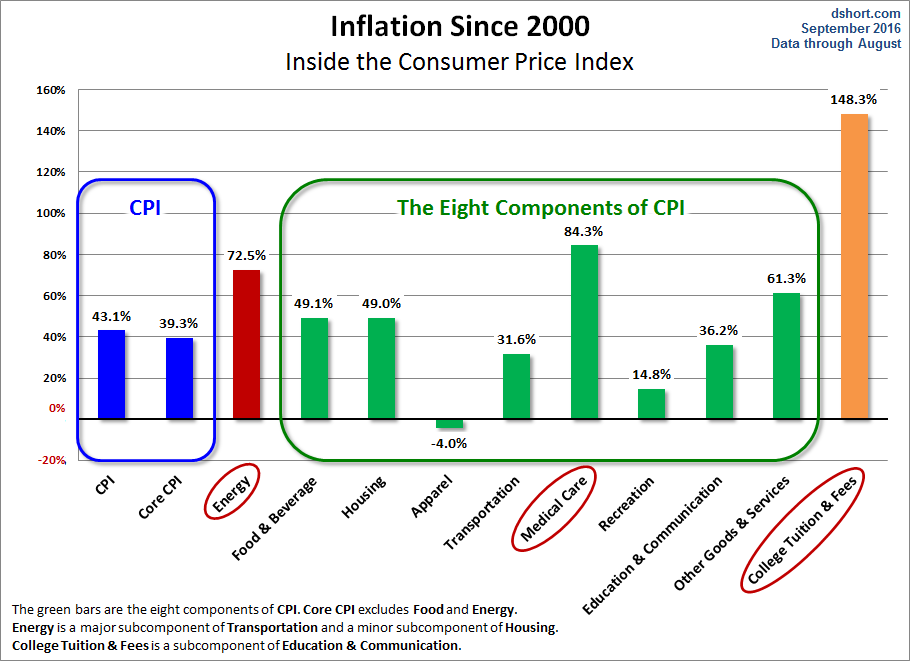April 2017 CPI: Year-Over-Year Inflation Rate Again Moderates
by Jill Mislinski and Steven Hansen
According to the BLS, the Consumer Price Index (CPI-U) year-over-year inflation rate was 2.2 % - moderating from than last month's 2.4 %. The year-over-year core inflation (excludes energy and food) rate moderated 0.1 % to 1.9 %, and is slightly below the target set by the Federal Reserve.

Analyst Opinion of the Consumer Price Index
Many elements of the CPI moderated this month lead by commodities - but the energy sector showed significant inflation.
The market expected (from Bloomberg / Econoday):
| Consensus Range | Consensus | Actual | |
| CPI-U - month-over-month (MoM) | -0.1 % to 0.3 % | +0.2 % | +0.2 % |
| CPI-U year-over-year (YoY) | 2.2 % to 2.5 % | +2.3 % | +2.2 % |
| CPI less food & energy (MoM) | 0.1 % to 0.3 % | +0.2 % | +0.1 % |
| CPI less food & energy (YoY) | 2.0 % to 2.2 % | +2.0 % | +1.9 % |

z cpi1.png
As a generalization - inflation accelerates as the economy heats up, while inflation rate falling could be an indicator that the economy is cooling. However, inflation does not correlate well to the economy - and cannot be used as a economic indicator.
The major influence on the CPI was again energy prices.
The Consumer Price Index for All Urban Consumers (CPI-U) increased 0.2 percent in April on a seasonally adjusted basis, the U.S. Bureau of Labor Statistics reported today. Over the last 12 months, the all items index rose 2.2 percent before seasonal adjustment.
Increases in indexes for shelter, energy, tobacco, and food all contributed to the monthly increase in the all items index. The energy index rose 1.1 percent, with all 3 of its major component indexes rising. The food index rose 0.2 percent, mostly due to a sharp increase in the index for fresh vegetables.
The index for all items less food and energy rose 0.1 percent in April after declining in March. The shelter index increased 0.3 percent, and the tobacco index increased sharply over the month. However, many indexes declined in April, including those for wireless phone services, medical care, motor vehicle insurance, apparel, used cars and trucks, recreation, and new vehicles.
The all items index rose 2.2 percent for the 12 months ending April. While a smaller increase than the 2.4 percent rise for the 12 months ending March, this is still a larger rise than the 1.7 percent average annual increase over the past 10 years. The index for all items less food and energy rose 1.9 percent over the last 12 months; this compares to a 1.8 percent average annual increase over the past decade. The energy index rose 9.3 percent over the last year, while the food index increased 0.5 percent.
Historically, the CPI-U general index tends to correlate over time with the CPI-U's food index. The current situation is putting an upward pressure on the CPI.
CPI-U Index compared to the Food sub-Index of CPI-U

Notice the gap in the above graphic between the CPI and Food - historically this gap has always closed when the knock-on effect from higher food prices into other CPI components moderates.
Recently, medical care too has been accelerating faster than costs in general. The graphs below compare health care to the CPI-U. Note that the rate of growth of healthcare costs is now at the levels seen prior to the introduction of Obamacare.
Month-over-Month Change CPI-U Index (red line) compared to the Medical Care sub-Index of CPI-U (blue line)

Year-over-Year Change CPI-U Index (red line) compared to the Medical Care sub-Index of CPI-U (blue line)

The Federal Reserve has argued that energy inflation automatically slows the economy without having to intervene with its monetary policy tools. This is the primary reason the Fed wants to exclude energy from analysis of consumer price increases (the inflation rate).

z cpi2.png
In the above chart - the green boxes are significant elements moderating inflation, while the red boxed items are significant elements fueling inflation.
The graph below looks at the different price changes seen by the BEA in this PCE release versus the BEA's GDP and BLS' Consumer Price Index (CPI).
Year-over-Year Change - PCE's Price Index (blue line) versus CPI-U (red line) versus GDP Deflator (green line)

Detailed Analysis
The first chart is an overlay of Headline CPI and Core CPI (the latter excludes Food and Energy) since the turn of the century. The highlighted two percent level is the Federal Reserve's Core inflation target for the CPI's cousin index, the BEA's Personal Consumption Expenditures (PCE) price index.

The next chart shows both series since 1957, the year the government first began tracking Core Inflation.

In the wake of the Great Recession, two percent has been the Fed's target for core inflation. However, at their December 2012 FOMC meeting, the inflation ceiling was raised to 2.5% while their accommodative measures (low Fed Funds Rate and quantitative easing) were in place. They have since reverted to the two percent target in their various FOMC documents.
Federal Reserve policy, which in recent history has focused on core inflation measured by the core PCE Price Index, will see that the more familiar core CPI is currently at the PCE target range of 2 percent.
Caveats on the Use of the Consumer Price Index
Econintersect has performed several tests on this series and finds it fairly representative of price changes (inflation). However, the headline rate is an average - and will not correspond to the price changes seen by any specific person or on a particular subject.
Although the CPI represents the costs of some mythical person. Each of us need to provide a multiplier to the BLS numbers to make this index representative of our individual situation. This mythical person envisioned spending pattern would be approximately:

The average Joe Sixpack budgets to spend his entire paycheck or retirement income - so even small changes have a large impact to a budget.

The graph above demonstrates that fuel costs, medical care, and school costs are increasing at a much faster pace than the headline CPI-U.
The Bureau of Labor Statistics (BLS) has compiled CPI data since 1913, and numbers are conveniently available from the FRED repository (here). Long-term inflation charts reach back to 1872 by adding Warren and Pearson's price index for the earlier years. The spliced series is available at Yale Professor (and Nobel laureate) Robert Shiller's website. This look further back into the past dramatically illustrates the extreme oscillation between inflation and deflation during the first 70 years of our timeline. Click here for additional perspectives on inflation and the shrinking value of the dollar.

Because of the nuances in determining the month-over-month index values, the year-over-year or annual change in the Consumer Price Index is preferred for comparisons.
Econintersect has analyzed both food and energy showing that food moves synchronously with core.
Disclaimer: No content is to be construed as investment advise and all content is provided for informational purposes only. The reader is solely responsible for determining whether any ...
more


